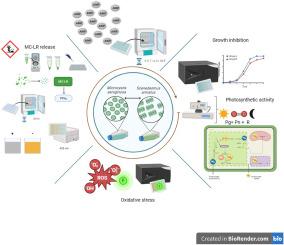Assessing the long-term adverse effects of aluminium nanoparticles on freshwater phytoplankton using isolated-species and microalgal communities
IF 8.1
2区 环境科学与生态学
Q1 ENVIRONMENTAL SCIENCES
引用次数: 0
Abstract
The physicochemical properties of aluminum oxide nanoparticles (Al2O3-NPs or AlNPs) allow them to remain suspended in water for extended periods. Despite this, AlNPs are one of the least studied types of metal nanoparticles and pose a significant risk to aquatic ecosystems. Therefore, it is essential to understand the toxic mechanisms of AlNPs on microalgae and cyanobacteria, as they can have adverse effects on the entire aquatic food web. Our research aimed to assess the toxicity of continuous exposure to low environmentally relevant concentrations of AlNPs on the growth rate, photosynthetic activity, oxidative stress (ROS), and microcystin production (MC-LR) in a phytoplanktonic community (PCC) consisting of Scenedesmus armatus and Microcystis aeruginosa. Both single and community cultures were exposed to 1.0 μg mL-1 AlNPs for 28 days. The results showed a significant 20–40% inhibition of S. armatus population growth in both individual and community cultures after 28 days of exposure. In contrast, M. aeruginosa exhibited increased survival and cell division rates when exposed to nanoparticles, both individually and within the community. Additionally, S. armatus showed a substantial reduction in gross photosynthesis (Pg) and net photosynthesis (Pn), with less inhibition in respiration (R) after 28 days of exposure. Conversely, M. aeruginosa demonstrated higher rates of photosynthetic productivity in all three parameters (Pg, Pn, and R). In the PCC, respiration was inhibited from 14 to 28 days, and both Pg and Pn were also inhibited. Both S. armatus and M. aeruginosa showed 28–31% levels of ROS generation, while the phytoplanktonic community exhibited no significant ROS production. Moreover, the production and release of MC-LR decreased by 8–38% in M. aeruginosa compared to the control strain. These findings underscore the importance of monitoring the use and application of nanomaterials to mitigate their potential toxic effects on aquatic ecosystems.

利用隔离物种和微藻类群落评估纳米铝对淡水浮游植物的长期不利影响
氧化铝纳米颗粒(Al2O3-NPs 或 AlNPs)的物理化学特性使其可以长时间悬浮在水中。尽管如此,AlNPs 仍是研究最少的金属纳米颗粒类型之一,并对水生生态系统构成重大风险。因此,了解 AlNPs 对微藻和蓝藻的毒性机制至关重要,因为它们会对整个水生食物网产生不利影响。我们的研究旨在评估持续暴露于低环境相关浓度的 AlNPs 对浮游植物群落(PCC)的生长率、光合作用活性、氧化应激(ROS)和微囊藻毒素产量(MC-LR)的毒性。将单个培养物和群落培养物暴露于 1.0 μg mL-1 AlNPs 中 28 天。结果表明,暴露 28 天后,单个和群落培养物中的腕栉水母种群生长均受到 20-40% 的明显抑制。相比之下,铜绿微囊藻在接触纳米颗粒后,无论是个体还是群落,其存活率和细胞分裂率都有所提高。此外,S. armatus 在接触纳米粒子 28 天后,总光合作用(Pg)和净光合作用(Pn)大幅降低,呼吸作用(R)的抑制作用较小。相反,铜绿微囊藻在所有三个参数(Pg、Pn 和 R)上都表现出更高的光合生产率。在 PCC 中,呼吸作用从 14 天到 28 天一直受到抑制,Pg 和 Pn 也受到抑制。S. armatus 和 M. aeruginosa 的 ROS 生成水平均为 28-31%,而浮游植物群落则没有明显的 ROS 生成。此外,与对照菌株相比,铜绿微囊藻的 MC-LR 生成和释放量减少了 8-38%。这些发现强调了监测纳米材料的使用和应用以减轻其对水生生态系统的潜在毒性影响的重要性。
本文章由计算机程序翻译,如有差异,请以英文原文为准。
求助全文
约1分钟内获得全文
求助全文
来源期刊

Chemosphere
环境科学-环境科学
CiteScore
15.80
自引率
8.00%
发文量
4975
审稿时长
3.4 months
期刊介绍:
Chemosphere, being an international multidisciplinary journal, is dedicated to publishing original communications and review articles on chemicals in the environment. The scope covers a wide range of topics, including the identification, quantification, behavior, fate, toxicology, treatment, and remediation of chemicals in the bio-, hydro-, litho-, and atmosphere, ensuring the broad dissemination of research in this field.
 求助内容:
求助内容: 应助结果提醒方式:
应助结果提醒方式:


